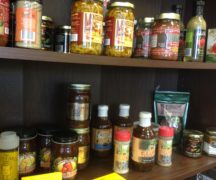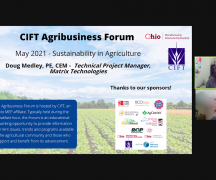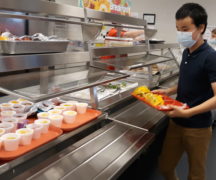By DAVID DUPONT
BG Independent News
A new initiative promises to turn the waste generated by large scale agriculture, sewage plants, and other sources into gold.
At May’s virtual Ag Breakfast sponsored by the Center for Innovative Food Technologies, those leading the project spoke about the potential for turning biowaste into energy and other useful products.
CIFT is one of regional entities across the nation working with the Agricultural Technology Innovation Partnership Foundation (ATIP).
Wes Jurey, the founder and CEO of ATIP Foundation explained how the project grew from his role as president of the Arlington, Texas Chamber of Commerce.
The project was launched in four counties in Texas.
The idea is to come up with economic development models that can work in areas around the country, that can be operate large or small scale, and that are economically sustainable.
Last year, the biomass project started laying the groundwork in eight counties in the San Joaquin Valley in California and in nine counties in Northwest Ohio with CIFT as lead agency.
The project has since started gathering data including a resource inventory – that includes manure from farms, food wastes from schools, hotels, and hospitals, and sludge from sewage treatment plants, and the contents of landfills.
Some treatment plants send their sludge to landfills. That’s “low hanging fruit,” Jurey said.
The project, said Rick Brenner, the director of the ATIP Foundation, takes advantage of waste materials and turns them into useful products.
Todd Campbell, of Clean Economy Works and the counsel for the foundation, said they were “agnostic” as to what materials they would work with. “We’ll let the markets decide what makes sense.”
They are also open to a variety of arrangements, he said. In some cases, the company may simply come in and install the needed equipment on the farm. In other cases, the farmer will contract with a firm to remove the waste and handle the whole operation.
Operations can be as small as a single farm or large plants that take in waste from an entire region.
One company, Jurey said, was looking at a multiphase process that would take farm waste to create biogas, chemical additives that could be sold on the commodities markets, and then return potable water into the environment.
About 54 companies, he said, have expressed interested in exploring the bioeconomic projects.
These companies would create a variety of jobs. The project needs to reach out schools , colleges and workforce development agencies.
Part of laying the groundwork involves finding funding through banks or venture capitalists.
Bankers often don’t realize, Jurey said, that the US Department of Agriculture makes more government-backed loans than the Small Business Administration.
“When you look at the total tonnage involved in agricultural waste, there’s definitely the possibility to create an industry,” he said.





